Retrobellish Beaded Fabric Cuff
Recently, I was looking through a fashion magazine and saw several jeweled cuffs that I really liked. Out of curiosity, I thought I’d try to make one of my own. It was a learning experience, because it took a longer time for me to choose the beads than the fabric. I had some interesting black and rustic gold striped fabric and then chose some beads that I thought would look nice against the fabric.
I lined up the beads and moved them around until I chose a pattern that I really liked. Then, instead of individually sewing each bead to the cuff, I decided that for flexibility I’d string about four beads and then tack them down (hand sewing a few stitches at the end through the cuff) before continuing with stringing the next four beads in the pattern I had chosen.
The finished cuff measured approximately 2 inches wide by 10 inches long. For fabric support, I used a 1/8 inch thick interfacing about a ¼ inch smaller than the fabric’s measurements. I wrapped the fabric around the interfacing and hand sewed the fabric with the seam in the back. I also sewed a small piece of solid black fabric over the seam in the back of the cuff to hide the seam and used a small black snap for the cuff’s closure.
Once I completed sewing the beads on the cuff, I felt that the cuff could use a little more embellishment around the edges, so I decided to crochet a small black trim. I used a size 3 crochet thread and size E/4 crochet needle. My simple pattern consisted of 60 chains in the first row. In the second row, I crocheted five chains and single crocheted into the third chain (of the first row). Then I repeated crocheting five chains and single crocheted through the third chain again, creating little loops. I repeated this crochet pattern for the other side of the cuff and then hand sewed both trims onto the cuff. I was really happy with the results.
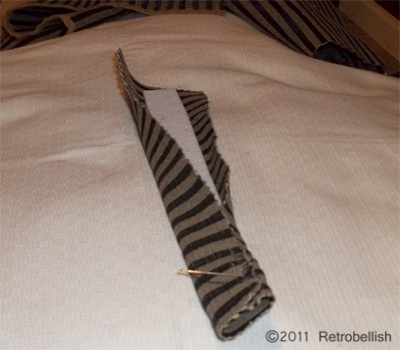
Starting The Beaded Fabric Cuff
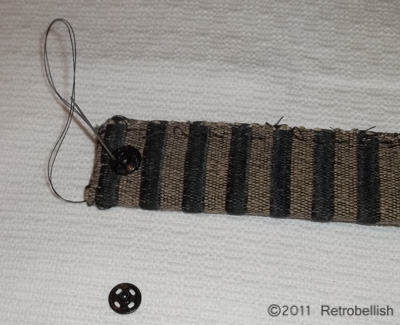
Sewing the Snap On Retrobellish Fabric Cuff
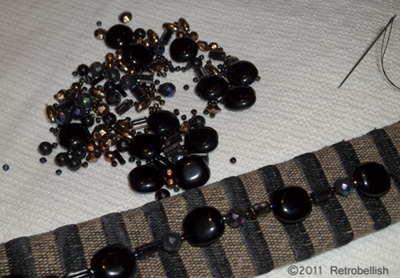
Making the Beaded Fabric Cuff
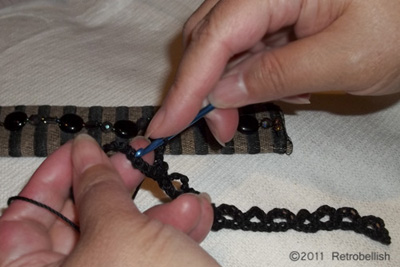
Crocheting the Trim for Beaded Fabric Cuff
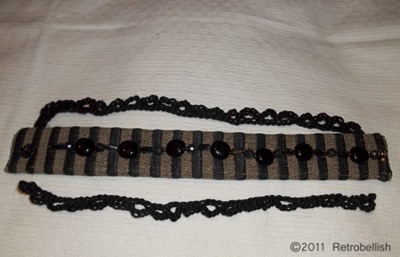
Ready to Sew On the Finished Trims
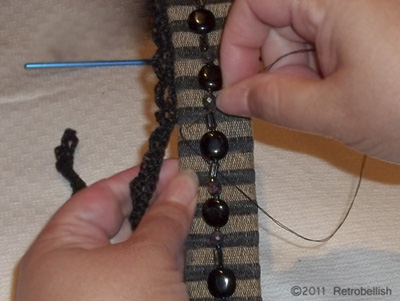
Attaching the Trim to the Finished Cuff
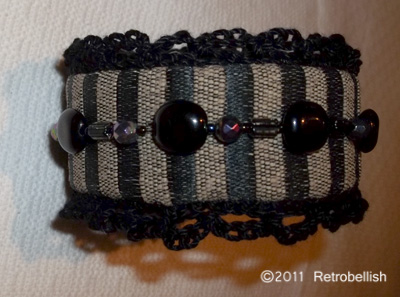
The Finished Beaded Fabric Cuff
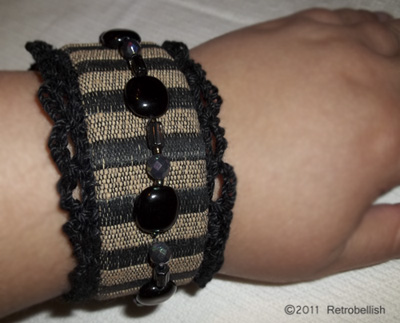
Wearing Finished Beaded Fabric Cuff
Blouse to Embellished Sequin Jacket
Earlier this year, I bought a beautiful black sequin trim at a clearance sale. And although at the time I had no idea how I would use this trim, I knew that someday a project would come along. The black sequin trim was two inches wide by three yards long.
Later this summer, I bought a black blouse with a beautiful open lace pattern. When I first saw the blouse I immediately thought of my black sequin trim and how great it might look sewn onto certain areas of this blouse. I started this project by removing the buttons from the blouse, cutting and sewing the collar and lapels down to the fabric of the blouse so that the trim would lay flat around the neckline.
I laid the blouse down flat on a table and rolled out the trim. I placed the beginning of the trim at the bottom edge of the left side of the blouse, pinning about a half inch of the trim over the edge (onto the wrong side) and then onto the front of the blouse. I carefully pinned the trim along the edge over the area where the button holes used to be and continued rolling out the trim all the way around the neckline. Once I completely pinned down the trim around the neckline, I continued rolling out the trim down the right side of the blouse over the area where the buttons used to be until I reached the bottom edge of the blouse (and a little over that edge as well so the cut end was on the wrong side). After measuring the leftover trim, I was glad to find out that I had enough to also embellish both cuffs.
Once I completed the embellishments, it was amazing to see how easy it was for a simple blouse to be transformed into a beautiful jacket by just using store bought trim.
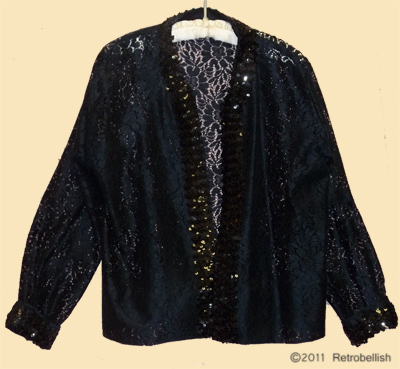
Embellished Sequin Jacket
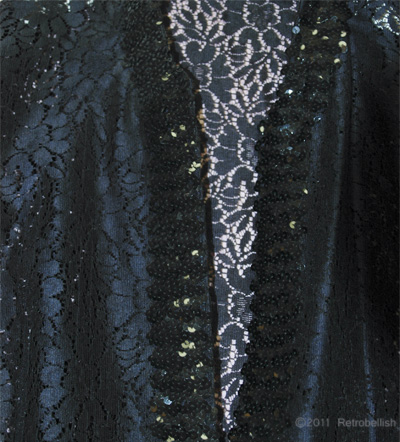
Sequin-Jacket-Trim
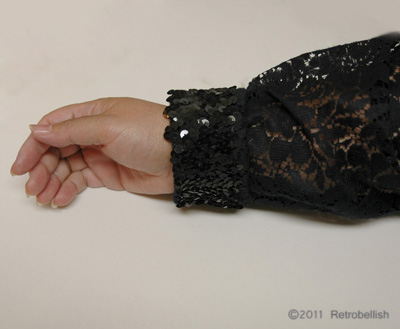
Sequin Cuff Closeup
Recycled Junk Mail Folk Art
One of the ways we have reclaimed some of the advertising brochures and junk mail around our home is to make paper-mache items. One of our favorite items we make are masks and wall plaques. This lion head which measures about 13″ x 8″ was made using some of the shredded junk mail and brochures that we receive at home during the week. We just used a traditional paper-mache paste that you might remember using in school made of flour and water and a little salt as a preservative. We made the paste in a bucket and then combined the paste and shredded paper together.
We then take this mixture and press it into the cement mold allowing it to dry before removing it from the mold. The lion head mold we used was for a cement lion head used in garden statuary. We then painted the lion head casting with multiple latex acrylic paints to create a faux iron patina for a rustic folk art look. Previously, we have also made this lion out of newspaper instead of the shredded material. This technique can also be made freehand allowing you to express your artistic creativity.
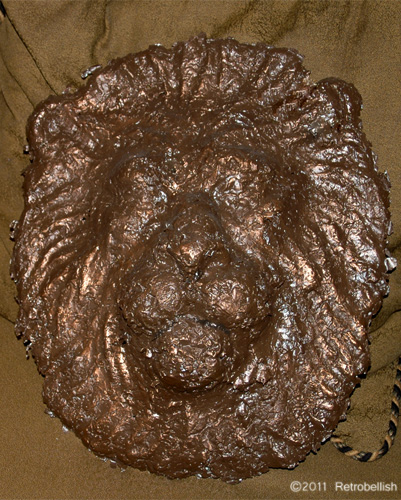
Reclaimed Paper Lion Face
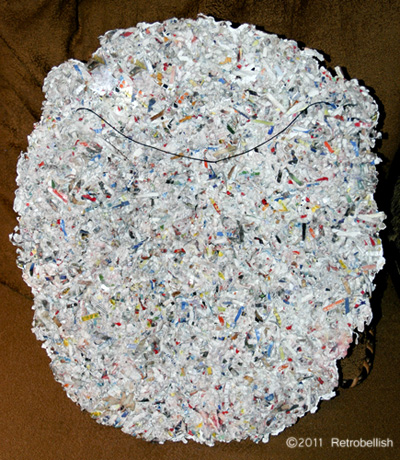
Reclaimed Paper Lion Back Showing Shredded Paper.
Folk Art Cat Painting On Recycled Paneling
We had some paneling pieces that we removed from one of our rooms some years back. We were able to give the big panels to a friend who was able to reuse them, but we had some odd pieces left that we wanted to use for crafting. We were able to cut the leftover pieces into perfect sizes so I could paint on them instead of canvas. I then gave them a primer coat of gesso. I started painting on them just for fun, but ended up selling some of my Cat pieces. The folk art cat painting featured here was one of the paintings that I painted on the recycled paneling in 2005 using acrylic paints
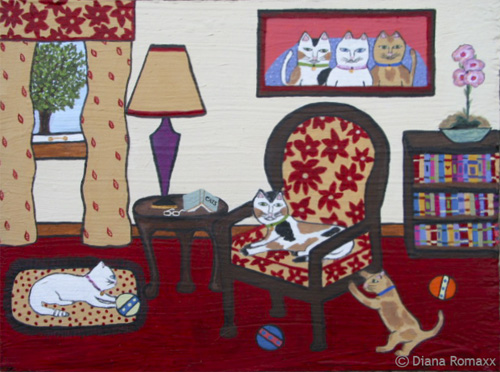
Folk Art Cat Painting On Recycled Paneling
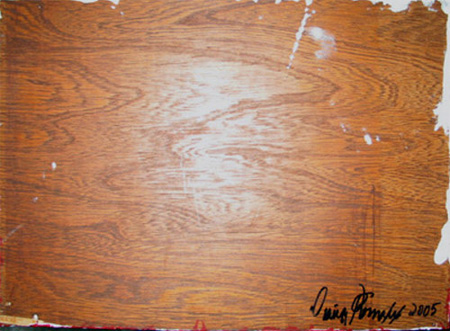
Folk Art Cat Painting Backside
Retro Pink Pearl Pin
I’ve always loved hats and living in the midwest gives me the opportunity to pull out my winter hats every year. The problem is that a lot of the hats made today have lost a lot of embellishment touches that they had in the past. My problem is that I go for warmth instead of style and a lot of the winter hats are just plain, and some even ugly, but boy are they toasty when the weather outside hits 10 below zero. One of the things that works for me as a crafter, is to embellish my hats with things I love like a crocheted flower, or pin, or knitted piece that I’ve made. This pearled fabric flower pin is very versatile because I chose to use a hat pin instead of a permanent attachment on the hat shown here. This way I can also pin it onto a purse, jacket, coat or other hat.
I used some vintage fabric, an old broken necklace for the pearls and leftover lace from another project to make this flower pin, and one of my old hats. I cut a two inch wide by 12 inch long strip of pink fabric and gently twisted the fabric while forming a circle. Then as I formed the center I started hand sewing the pearls onto the fabric. Next I continued gently twisting the fabric strip until the flower reached a size that I liked. Then I tucked the end under and stitched a knot there to complete the flower. I started hand sewing the lace trim onto the underside of the flower slightly gathering the lace as I sewed it on until it reached all the way around.
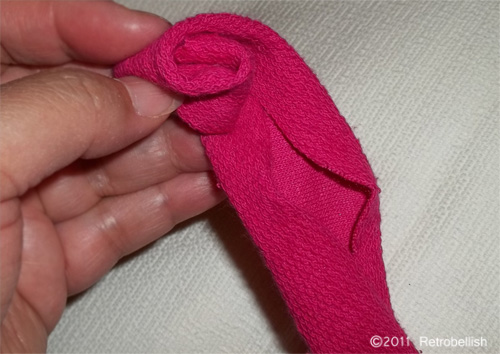
Starting the Pink Pearl Flower
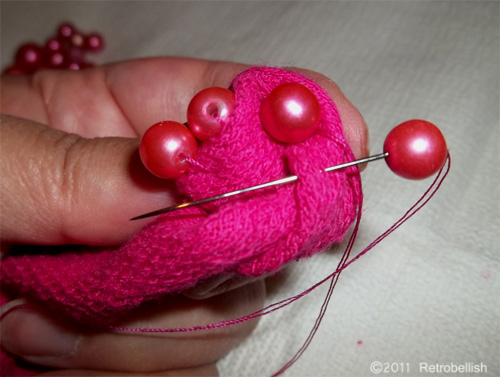
Adding the Pink Pearls
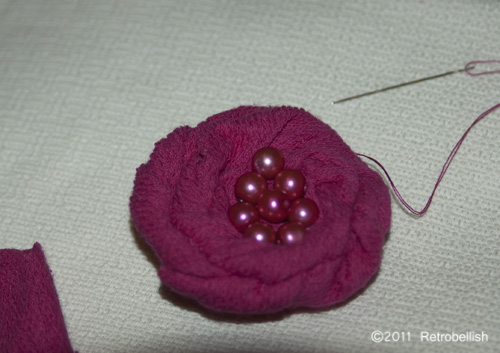
Pink Pearl Pin Flower
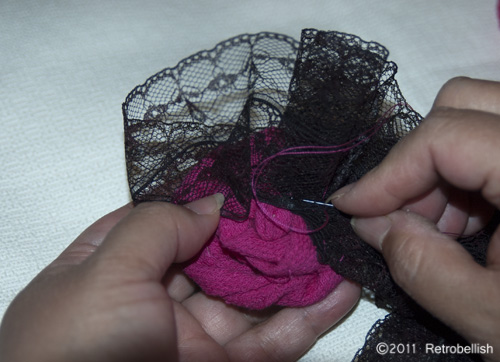
Adding Black Lace to Flower
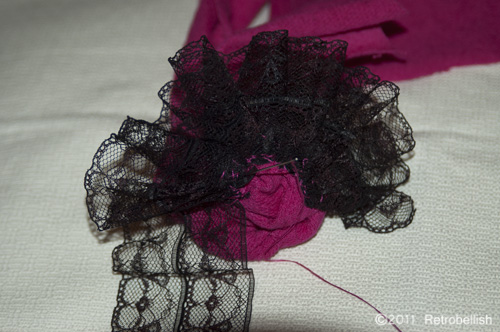
Sewing Lace on the Back of the Flower
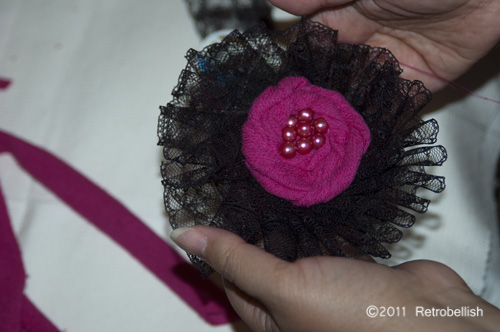
The Finished Pink Flower Pin
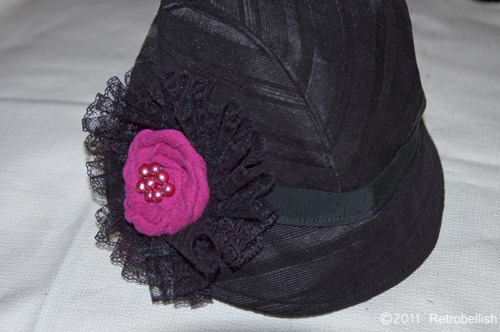
Finished Flower Pin on Black Retro Hat